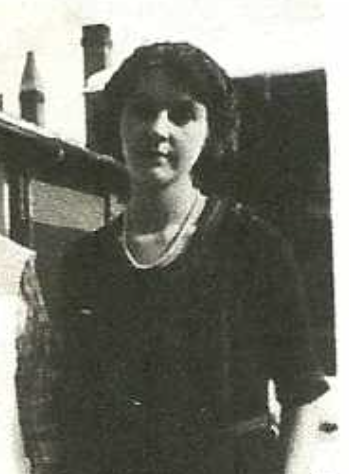
Eleanora Marian Streadbeck,
Labor Union Striker
1900 – 1993
“I want to do something. I feel that this is a time when all Americans should be together and I want to do what I can.”
By Rebekah Clark, Better Days Historical Director
The demand for labor during World War I brought many women to the workforce for the first time. Like many early nineteenth-century workers facing challenging work conditions, these women often chose to participate in labor unions. Most trade unions had a branch for its women members, who participated in all activities including fundraising, event organization, and even strikes. Eleanora Streadbeck, a young worker from Salt Lake City, took a stand against labor injustice and helped promote better protections for female workers.
Eleanora Marian Streadbeck was born in Salt Lake City to Swedish parents Peter Johannson Streadbeck and Kjersti Olsson, who had converted to the Church of Jesus Christ and immigrated to Utah in 1878. Eleanora was the youngest of nine children. Throughout her life, she demonstrated a strong desire to join with others in an important cause. As the United States prepared to enter World War I, Eleanora first applied for enlistment at the local army recruiting station in March 1917, but she was rejected because the army at the time did not accept women into its official military ranks. The recruitment officers directed her to the Red Cross headquarters instead, where she registered as a volunteer. Eleanora lamented: “Why was I not born a boy, then I could have got into the army and do[ne] something for my country if there is a war? I want to do something.”[1]

Western Union Messenger Girls, 1917. Courtesy of the Utah Historical Society.
Eleanora soon had the opportunity to “do something.” The next year, on May 3, 1918, she was fired from her job at the Western Union Telegraph Company in Salt Lake City. She and four of her coworkers, all young women, were members of the local worker’s union. When the Western Union employers discovered their union membership, they threatened to discharge the women unless they left the union. Knowing that unionizing was legal and protected under labor legislation passed in Utah the previous year, they refused and were consequently fired.

Helen Henefer, one of the Western Union strikers, at age 19. Used by permission from Sharon Bunker, Helen’s granddaughter, who expressed that she was unsurprised that Helen was involved in workers’ rights. Sharon said that Helen was an officer of Daughters of the Utah Pioneers and that she “lived a life of service.”
Eleanora, along with Helen Henefer, Elizabeth Davidson, Melba Timpson, and Katherine Goodman, responded to their unlawful termination by organizing to protest the Western Union Telegraph Company. Their male coworkers helped them continue their strike by giving them part of their wages every week. Eventually, Western Union Telegraph met their demands and the women returned to work.
Eleonora and her co-workers were not the only women who found themselves as new union members during that time. Another example of a strike happened in Ogden, when ten union women walked out of their waitress jobs at Kennedy Restaurant because the owner would not agree to raise the wages (the women were asking for $1.50 for each eight-hour work day). They joined with union men to picket the restaurant. Police were called, but they could not arrest the picketers because they were walking up and down the street, not technically loitering. The strike lasted ten days, during which local men with membership in any union boycotted the restaurant. The owners eventually agreed to meet the workers’ demands.[2]

The Women’s Auxiliary of the Machinists Union, 1918. Salt Lake Tribune, July 31, 1918.
Strikes were common during this time and happened in every industry. Most women strikers demanded higher wages or better working conditions, but there were also instances of strikes taking place for other reasons. Elevator operators at Newhouse Hotel walked out for better uniforms, and women working switchboards in Price, Utah went on strike after their windows were boarded to prevent them from talking to passing young men.[3] Not every strike was immediately successful. When ten young women walked out of their jobs at Cache Knitting Works to demand better wages, they were denied and quickly replaced. They were left with no other option than to find lower-paying jobs in the beet and apple industries.[4]
Whatever the reason and results of each strike, these union women became part of Utah’s long history of labor movements for better conditions for workers. Utah unions during the early twentieth century helped protect against child labor laws and ensure that workers got paid what they deserve. It was because of union efforts that Utah became the first state in the United States to codify an eight-hour workday. Like Eleanora Streadbeck, as more and more women joined the workforce during World War I, they became leaders in these important efforts.
[1] “Girls Are Patriotic: Two Try to Join Army, Sent to Red Cross,” Salt Lake Herald-Republican, March 23, 1917, p. 16.
[2] See “Cooks and Waiters Go Out on Strike,” Salt Lake Tribune, June 7, 1918, p. 15; “Picketing Resumed by Ogden Strikers,” Salt Lake Tribune, June 8, 1918, p. 9; and “Restaurants are Now Unionized and are Being Patronized,” Ogden Daily Standard, June 19, 1918, p. 5.
[3] “Girls on Elevator Jobs Strike; They Want Chic Uniforms,” Salt Lake Telegram, October 2, 1917, p. 2; “Phone Girls on Strike,” Salt Lake Telegram, August 26, 1916, p. 8.
[4] “Higher Wage Demanded by Factory Girls,” Logan Republican, October 20, 1917, p. 1.

